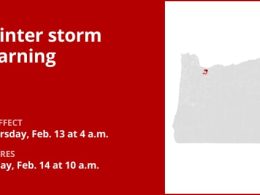At 12:04 p.m. on Tuesday, the National Weather Service issued an updated coastal flood advisory for the Clatsop County Coast, which is in force until 2 p.m.
In addition, the weather service warns of “Tidal overflow flooding.”
“Minor flooding, up to one foot above ground level, during high tides is expected in the low-lying areas near bays, sloughs, and the lower reaches of the coastal rivers,” according to the weather service. “Tidal overflow flooding is anticipated when there is a coastal flood advisory in effect. Residents living along the coast in the region under warning should be on the lookout for rising water and take the necessary precautions to save lives and property.
Your guide to weather alerts: advisories, watches, and warnings
-
Flash flood warning: Take action!
When a flash flood is either approaching or has already occurred, a warning is given. Moving to higher ground right away is essential in places that are prone to flooding. A flash flood is a quick, intense flood that can form in a matter of minutes to hours and even occur in places that aren’t currently receiving any rain.
-
Flood warning: Take action!
When flooding is expected or is happening, a flood warning is issued.
-
Flood advisory: Be aware:
When flooding is not predicted to be severe enough to warrant a warning, a flood advisory is issued. But if care is not taken, it could result in circumstances that endanger life and/or property and cause a great deal of discomfort.
-
Flood watch: Be prepared:
When the weather is conducive to flooding, a flood watch is issued. Flooding is not guaranteed, but it is a possibility.
When floods strike: Guidelines from the weather service for your protection
Knowing and adhering to the weather service’s flood safety recommendations can be extremely helpful when camping in low-lying areas or in places that are prone to flooding:
Look for higher ground.
Moving to higher ground is the first line of defense if you live in an area that floods easily or are camping in a low-lying area.
Respect evacuation directives:
Immediately comply with any evacuation orders issued by local authorities. Make sure your house is locked before you leave.
Cut off appliances and utilities:
Disconnect your appliances and utilities if you have the time. By taking this precaution, electrical dangers during flooding are reduced.
Steer clear of waterlogged regions and basements:
Stay away from rooms with electrical outlets or cords that are submerged in water or basements. Electrical accident prevention is essential.
Quickly leave for your safety:
Evacuate right away if you see sparks or hear popping, crackling, snapping, or buzzing noises. Avoid going into water that might be electrically charged.
Avoid the floodwaters:
Even if floodwaters seem shallow, you should never try to go over them. You can be swept off your feet with power by just 6 inches of swift-moving water.
When stuck, look for higher ground:
If you find yourself caught by flowing water, move to the highest spot you can and dial 911 to reach rescue personnel.
Flooding is a possibility during periods of high rainfall, particularly in low-lying and flood-prone locations. Never drive on water on the road, even if it appears to be shallow. The weather service claims that most cars can be washed away by as little as 12 inches of swiftly moving water. Put your safety first by being aware and ready.
United Robots offers a service called Advance Local Weather Alerts that gathers the most recent information from the National Weather Service using machine learning.










